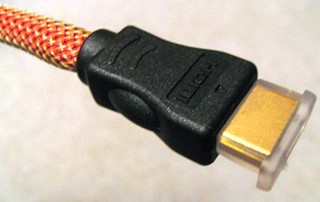Introduction
The subject of cables will cause debate with just about any group of A/V
aficionados. How much should you spend on these things? Many believe
that the only difference youíll find is the pretty braiding or nice name
attached to the packaging.
When all we had to deal with was analog signals up to about 100 kHz, all
cables worked reasonably. But now that cables handle digital signals, and in
the MHz frequency range, problems have started arising.
The Frustration of Design
At CEDIA - 2005, in Indianapolis, Indianaa, one of the booths I visited was Paradigmís in
anticipation of seeing the new Anthem D2 Surround Sound Processor. While I was there
I talked with them about how things were going, and they mentioned how much
trouble they were having with HDMI cables. Essentially most of the cables they
tested would not pass a
1080p output they were providing to their projector without dropouts or "sparklies".
Sparklies look like random white specs in the image.
Sometimes Paradigm couldn't get a signal through at all. This wasnít even a
very long run, somewhere in the order of around 25 feet. In my own room, I use an
HDMI cable run of about 30 feet from my equipment to my projector. While I hadnít
experienced sparklies yet, I did have more than persistent dropouts and the
end connector on the equipment side seemed to be getting looser and looser as
I switched components manually.
After my conversation with
Paradigm I took it upon myself to keep a look out for HDMI cables that seemed
to have better build quality than what I was typically seeing. Eventually this
led me to several booths, including Nordost, whose various cables have been
reviewed here many times over, including the new WyreWizard line. When I asked
them about HDMI cables
specifically, they said they had just released an HDMI cable in the WyreWizard
line. I mentioned the issues I was having at home with frequent
dropouts and the construction of the cable being a likely culprit. He showed
me their new offering and how substantial the terminations were in comparison
to most HDMI cables Iíve seen.
The Goods
 So,
later, at the Rocky Mountain Audio Fest, in Denver, Colorado, I obtained one
of these new cables for testing.
So,
later, at the Rocky Mountain Audio Fest, in Denver, Colorado, I obtained one
of these new cables for testing.
Right
away, I was extremely impressed with the quality of the cable construction. The outer shielding uses a familiar mesh that most high end cables use,
but the terminations were the most impressive aspect. There is really no room
for bending. The cable I was using before had a lot more flexibility where
the cable met the connector and I think this created issues with the internal
soldering points.
When I talked with Joe Reynolds
from Nordost, he informed me that their termination is actually a
min-microchip that uses silver solder for its connection points and then is
molded over with Polyethylene. This contributes to the solid connection point
and lack of issues when it comes to dropouts. The cable uses 22AWG wire that
consists of silver plated 99.9999% oxygen free copper (OFC). The cable is then
double shielded with foil and a braided shield and tested to
the HDMI specification.
The WyreWizard HDMI cables are guaranteed out to 15 meters and
come in pre-made lengths of 1, 2, 3, 6, 10, 12 and 15 meters. The starting price is
$139.99 for a one meter cable and $10 per extra meter after that. This puts
the 10 meter length cable that I used for this review at $229.99 which is actually a lot less than many of the HDMI cables I looked at
during my trip to CEDIA.
Because this design is
stiffer than most HDMI cables Iíve dealt with in the past, I would caution
users who do not
leave a lot of room behind their components for cabling, and require a certain
amount of elasticity in their cables for nearly 90 degree bends. You can't
bend to make sharp turns. You should be sure you have adequate space behind the component
to allow for the stiffer termination and overall construction of the cable
itself. I would say a good 5-6Ē of clearance is needed to allow for the
natural radius of the cables to bend without putting undue strain on it.
Click Here to Go
to Part II.